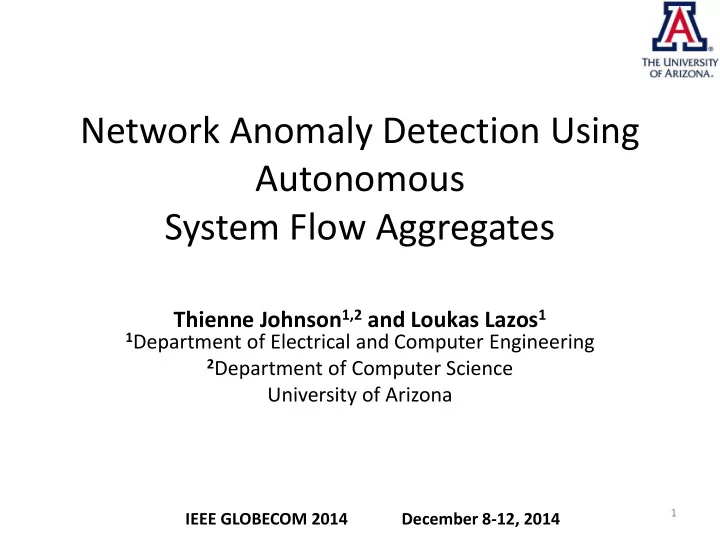

Network Anomaly Detection Using Autonomous System Flow Aggregates Thienne Johnson 1,2 and Loukas Lazos 1 1 Department of Electrical and Computer Engineering 2 Department of Computer Science University of Arizona 1 IEEE GLOBECOM 2014 December 8-12, 2014
Network Anomalies 2
Characteristics of Network Anomalies Examples Anomaly Characteristics Variations in DDoS (D) DoS against Number of packets and a single victim number of flows Alpha Unusually high rate point Number of packets and to point byte transfer volume Scan Scanning a host for a Incoming flows to a vulnerable port (port scan) host:port Scanning the network for Incoming flows to a port a target port (network scan) number 3
Anomaly detection Deep packet inspection • scalability problem in terms of computational and storage capacity Flow aggregation techniques • merge multiple flow records with similar properties, and discarding benign flows • summarize IP flows to statistical metrics – reduce the amount of state and history information that is maintained • At IP flow level: computation and storage requirements for an online NIDS can still be prohibitively large 4
Our Goals • To reduce communication and storage overheads – By exploiting the organization of the IP space to Autonomous Systems (ASes) • To detect large-scale network threats that create substantial deviations in network activity compared with benign network conditions 5
AS level anomalies at a monitored network 6
Methodology 2 3 4 1 5 7
– IP-to-AS Flow Translation 1 Each AS flow: Aggregate IP flows - Number of IP flows to AS flows - Number of IP packets - Volume (Bytes) 8
– IP-to-AS Flow Translation 1b Each AS flow: Aggregate IP flows - Number of IP flows to AS flows - Number of IP packets - Volume (Bytes) 9 Source IP A :Port → Destination IP T :Port AS X → AS T Source IP B :Port → Destination IP T :Port Source IP C :Port → Destination IP T :Port Source IP D :Port → Destination IP T :Port AS Y → AS T Source IP E :Port → Destination IP T :Port AS Z → AS T Source IP F :Port → Destination IP T :Port
– Metrics for data aggregation 2 Different anomalies affect different network flow parameters During aggregation period A: 1. Packet count (N): number of packets associated with the AS flow 2. Traffic volume (V): traffic volume associated with the AS flow 3. IP Flow count (IP): number of IP flows associated with the AS flow 4. AS Flow count (F): The number of AS flows that are active .Flows from spoofed IP addresses (network/16) are aggregated as a flow from Fake AS nodes .Flows from ASes not contacted before could be an anomalous event 10
– Data aggregation 2b Training Phase: intervals I 1 ,...,I m . Traffic for each of the m intervals is represented by the same model. Online Phase: traffic model for the online phase is computed over an epoch, which is shorter than an interval. Collect k samples for each metric using the aggregate values over k aggregation periods 11
– Statistical Analysis 3 For every AS flow, and every metric: 12
– Statistical Analysis 3b Real-time data D X Measure statistical divergence Training data pmf Jeffrey distance Λ 𝑄, 𝑅 = 1 2 (𝐿𝑀 𝑄, 𝑅 + 𝐿𝑀 𝑅, 𝑄 ) where (KL(P,Q) if the Kullback-Liebler divergence 𝑙 𝐿𝑀 𝑄, 𝑅 = 𝑞 𝑗 × log 𝑞 𝑗 𝑟 𝑗 𝑗=1 13
– Statistical Analysis 3c Distances are normalized to ensure equal distance scales when multiple metrics are combined to one Λ 𝑄 𝑗,𝑘 𝑁 , 𝑅 𝑘 (𝑁) 𝐾 𝑄 𝑗,𝑘 𝑁 , 𝑅 𝑘 (𝑁) = Λ 𝑄 𝑗,𝑘 𝑁 , 𝑅 𝑘 (𝑁) 95𝑢ℎ Value that fall in the 95 th percentile of historical distance for metric i accumulated over moving window W 14
– Composite Metrics 4 To capture the multi-dimensional nature of network behaviors, composite metrics combine several basic metrics weighting formula among the 𝑫 𝒋 = 𝑯 𝒋 𝑲 𝑶 , 𝑲 𝑾 , 𝑲 𝑱𝑸 , 𝑲 𝑮 different metrics Weights could be adjusted to favor a subset of metrics, depending on the nature of the anomaly to be detected. Foreach Epoch Ci > Threshold? Alert abnormal behavior 15
- Training data update 5 Moving window mechanism for maintaining the training data D(E,W) < Threshold Update 16
Case study MIT LLS DDOS 1.0 intrusion dataset which simulates several DoS attacks and background traffic. Anomaly in AS A 17
Anomaly in AS B Anomaly in AS C 18
Volumetric analysis – no AS distinction 19
Example of use with IMap Anomaly scores per AS Fowler, J; Johnson, T; Simonetto,P; Lazos, P; Kobourov, S.; Schneider, M. and Acedo, C. IMap: 20 Visualizing Network Activity over Internet Maps, Vizsec 2014.
Conclusions & Future work NIDS based on AS flow aggregates. • Reduction in storage and computation overhead Basic network anomaly detection metrics are adapted to the AS domain Composite metrics of network activity combine several basic metrics New basic metric that counts the number of AS flows for detecting anomalous events Formal study on composite metrics targeting known anomalies 21 Work supported by Office of Naval Research under Contract N00014-11-D-0033/0002
Thank you! http://www.cs.arizona.edu/~thienne NETVUE website: http://netvue.cs.arizona.edu/ 22 IEEE GLOBECOM 2014 December 8-12, 2014
Recommend
More recommend